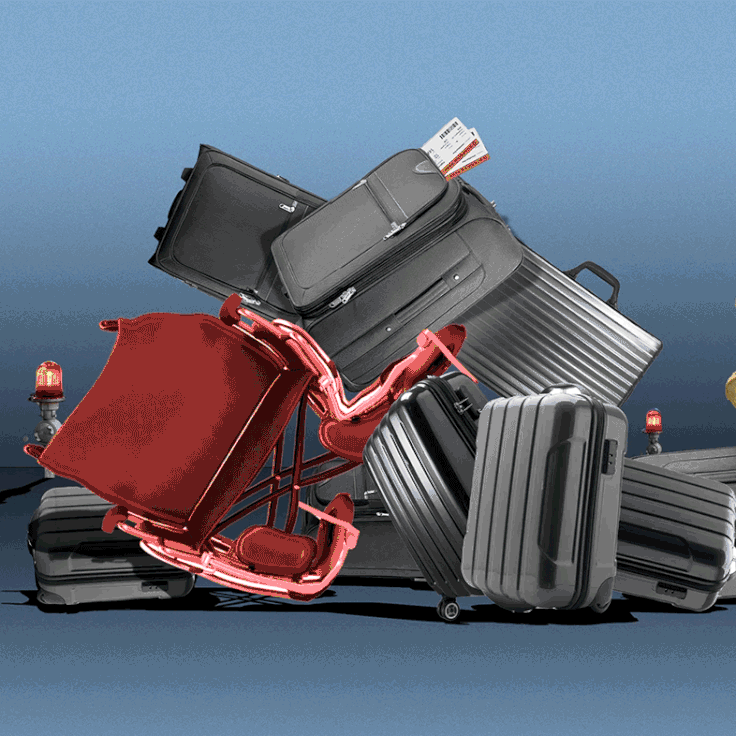I hate flying. Well, that’s not completely true. I don’t mind the actual flight; I just dread all the things that could go wrong between buying a ticket and getting to my destination.
Here’s how it usually goes: I wave goodbye to my wheelchair at the door of the airplane as I’m transferred into a special aisle chair because standard wheelchairs don’t fit through the narrow aisles. I am then unceremoniously dragged through the plane on the aisle chair by the airport assistance crew. Contrary to what many believe, wheelchair users are often boarded last, so every other passenger is able to look on as I am helped to my seat. The reasoning behind this, I found after inquiring with one airline I had a negative experience with, is curious.
“Ryanair policy is to board passengers who require assistance first where possible, however in some jurisdictions, local law prohibits [fueling] with special assistance passengers on board and therefore, they are boarded last once fuelling has been completed,” a representative wrote to me in response to my inquiry. “In airports such as Schiphol [Amsterdam], where we are required to load passengers using airbridges, special assistance passengers will generally be boarded last also.”
This past August, I flew from Dublin to Amsterdam on Ryanair for the second year of my graduate program in journalism, media and globalization. Along with the excitement to continue my studies, I felt the usual anxieties about traveling with my wheelchair.
The worst part of flying for me is spending the journey anxiously waiting to see if my wheelchair has made it safely to the other side. I’ve heard too many horror stories of wheelchair users being left stranded when they disembark the plane because their wheelchair has been lost or damaged during the flight. And to be perfectly clear for those who might have a bone to pick with any of the airlines mentioned in this piece — neglect and mistreatment of mobility aids happen on every airline and in every airport. It’s systemic ableism in full force.
When my flight landed on this particular evening, the aisle chair (which I have to sit on to be pushed off the plane) was not ready for me to use, so my boyfriend and I sat on the empty plane for 20 minutes after everyone deboarded. Finally, the assistance arrived, and I was reunited with my wheelchair. I pushed the button on the battery-powered component of my wheelchair. It didn’t work. Before starting to panic, I pressed it again. Nothing.
Looking closer, the damage was evident. The main wire connecting the battery to the motor was completely severed — from being roughly handled and placed below the passenger deck of the airplane for the journey, I assumed. Because the flight was delayed and I didn’t disembark right away, it was past 11 at night, and the service desk was closed.
If I hadn’t been with my boyfriend, I don’t know how I would have gotten home. Tired, upset and angry, I had no way to fix the problem that late at night, so my boyfriend pushed the manual part of my chair out to the taxi queue.
Mistakes are an unavoidable part of any travel, but what wheelchair users face when flying goes beyond just harmless mishaps; we face a big middle finger to our freedom and well-being.
I took to Twitter to vent my frustrations about my broken wheelchair when I was in a taxi. Over the next few days, I received thousands of retweets, likes and comments — some kind and supportive, some not so much.
My mentions were flooded by fellow wheelchair users with similar stories. Sif Holst, a Danish disability activist, told me that it took five months to get a replacement when her wheelchair was damaged on a flight from Copenhagen, Denmark, to Keflavik, Iceland, with Iceland Air in September 2021.
If it weren’t for the attention my tweet garnered, I doubt Ryanair would have replied to my emails. The airline told me that it could offer me up to 1,500 euros for the cost of repairing my wheelchair and for a rental in the meantime. I was reluctant to take them up on a rental, remembering the story of a disabled woman who died from an infection caused by a pressure sore that reportedly developed from a rented wheelchair when hers was damaged on a flight.
Still, I accepted their offer, ordered the replacement motor and wire online, and found a technician who was familiar with my type of device and eager to help. The technician, John, has a daughter who uses a wheelchair, so he understood the dire situation I was in. Thankfully, I didn’t have to wait for five months like Holst, and my wheelchair was fixed in a little under a month.
Ryanair has been reluctant to take the blame for what happened. When I reached out to inform the airline I’d be writing about my experience, a representative explained that although they are sympathetic, “Ryanair passenger baggage is handled by a third-party provider at Schiphol Airport – not by Ryanair.” I understand the reasoning here, but I feel deeply upset that my wheelchair, an item I could not survive without, was being compared to a run-of-the-mill roller bag with vacation clothes in it.
During the time without my motorized wheelchair, my independence was gone and I didn’t feel like myself. My boyfriend had to return to Dublin for work, and I despaired at the thought of being stuck alone in my apartment. Only when necessary, I got taxis to and from my university and ordered takeout for two weeks while I looked for a solution. I kept and submitted receipts to Ryanair, but the airline told me that only repairs and rentals could be paid for with the money it was offering. Having to pay out of pocket for the rest of my “incidentals,” my savings took a significant hit.
Fellow wheelchair-user Anna Landre had a similar experience when she flew (on another airline) from Washington, D.C., to Miami in 2019. Similarly to Holst, Landre believes that airlines should be compensating wheelchair users more substantially when they mess up.
”What we also need is for airlines to be required to pay larger damages when they strip someone of their mobility like this,” says Landre, who theorizes that there is likely no incentive for airlines to better protect passengers’ mobility aids because of the small sum they end up paying for wheelchair repair. Holst also calls for stricter legislation globally that would ensure quick and full compensation for damages.
But how can airlines and airports prevent this from happening in the first place?
Mistakes are an unavoidable part of any travel, but what wheelchair users face when flying goes beyond just harmless mishaps; we face a big middle finger to our freedom and well-being. Both Holst and Landre advocate for the ability to bring wheelchairs onto the airplane. This idea is dismissed by many airlines who argue that airplane seats are constructed to ensure passengers’ safety in the case of impact, and wheelchairs just wouldn’t serve the same purpose.
In a speech two months ago, U.S. Secretary of Transportation Pete Buttigieg pledged to work toward new regulations allowing passengers to remain in their wheelchairs during flights. “No other form of transportation — trains, buses, boats — forces you to give up your mobility device when you board,” he said. “The same should be true for airlines.”
I agree. But until that comes to fruition, I plan to buy extra insurance for every flight I take. And I hope that sharing my experiences — and tapping into the productive rage of my peers — will spark some conversations and some positive change.

